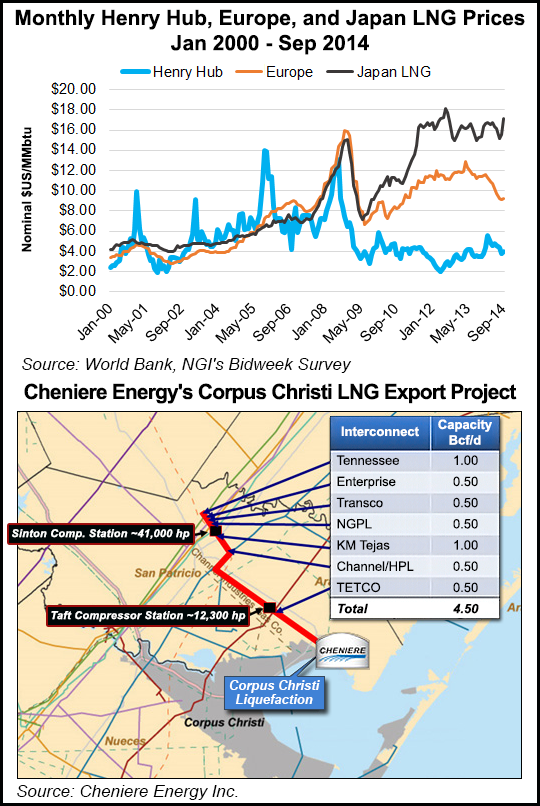Regulatory | LNG | NGI All News Access | NGI The Weekly Gas Market Report
FERC Issues FEIS for Cheniere Corpus Christi Export Project
FERC has issued the final environmental impact statement (FEIS) for Cheniere Energy Inc.’s planned Corpus Christi, TX, liquefied natural gas (LNG) export terminal. There are no insurmountable environmental obstacles to the project, Commission staff found.

The FEIS [CP12-508, CP12-507] arrived according to the timeline expected, analysts at ClearView Energy Partners LLC said Wednesday. A Federal Energy Regulatory Commission order authorizing construction of the project is expected in 40-60 days, or by year-end, they said.
Project opponents could file for rehearing within 30 days of the order. ClearView said it does not expect the U.S. Department of Energy (DOE) to issue final authorization for exports from Corpus Christi to non-free trade agreement (FTA) countries until after any rehearing request is settled. One such request could come from the U.S. Environmental Protection Agency, which said in August the Commission’s draft EIS erred in not considering the effects of increased gas production that could be induced by exports from Corpus Christi (see Daily GPI, Aug. 11).
Cheniere filed its non-FTA application at DOE at the end of August 2012 and has yet to receive conditional non-FTA export authorization. DOE so far has issued eight conditional non-FTA authorizations and three final authorizations, the most recent being those for Cameron LNG and Carib Energy (see Daily GPI, Sept. 10). Late last month, FERC authorized construction of Dominion Cove Point LNG LP in Calvert County, MD (see Daily GPI, Sept. 30).
The export terminal slated for Corpus Christi is Cheniere’s second and its first greenfield project. Construction is under way at the company’s Sabine Pass terminal in Louisiana, a brownfield project at the site of existing regasification facilities (see Daily GPI, June 6).
At Corpus Christi, Cheniere would construct the terminal on a 991-acre site along the northern shore of Corpus Christi Bay at the north end of the La Quinta Channel in San Patricio and Nueces counties. It would include three liquefaction trains, each capable of liquefying about 700 MMcf/d.
Cheniere plans to construct and operate about 23 miles of 48-inch diameter gas pipeline and two compressor stations to support the project. Additional ancillary facilities include six meter and regulator stations installed at the terminal as well as interconnects with Texas Eastern Transmission LP, Kinder Morgan Tejas Pipeline LLC, Natural Gas Pipeline Company LLC, Transcontinental Gas Pipe Line Co. LLC and Tennessee Gas Pipeline Co. LLC.
FERC staff enumerated 104 mitigation measures for Cheniere to take. Staff also assessed project alternatives and found none to be more desirable than what Cheniere has planned at Corpus Christi. “If the project is not approved and built, the need could potentially be met by other LNG export and import projects developed elsewhere in the Gulf Coast region or in other areas of the U.S.,” staff said. “Implementation of other LNG export/import projects would likely result in impacts similar to or greater than those of the proposed project.”
© 2024 Natural Gas Intelligence. All rights reserved.
ISSN © 1532-1231 | ISSN © 2577-9877 | ISSN © 1532-1266 |
